Table of Contents
Key Takeaways
- Most insects and spiders are not dangerous for household pets.
- Some spiders are poisonous though, including black widows and brown recluses.
- Scorpions can sting pets and are common in the Southwest.
- Rattlesnakes, coral snakes, and cottonmouth snakes are all poisonous.
- Healthy Paws insurance covers treatment for poisonous bites and stings.
Whether it’s insects or spiders in your home, or snakes you encounter while out on a hike with your pooch, pet parents should be aware of what critters are poisonous and what to do if their pets are exposed to them.
Insects and spiders
Generally, the insects and spiders you may see crawling around your home are not toxic to cats and dogs; they are more of a nuisance than anything else. That being said, there are a few little creatures that can be quite dangerous and toxic to our pets. This article will highlight these toxic pests and give you pointers for keeping insects and spiders out of your home, and avoiding snakes if you are outside.
Symptoms of a poisonous bite
Sometimes you’re not sure if your dog or cat has ingested a toxic food or substance or if they’ve had a run-in with a poisonous pest. The symptoms are remarkably similar: dilated pupils, drooling or foaming at the mouth, rapid heartbeat, nosebleeds, seizures and abnormal behavior. Additionally, there are other physical symptoms that are likely to be present:
- Presence of a bite or puncture wound
- Pain
- Skin that is inflamed:
- Red, swollen, and/or hot to the touch
- Necrotic (dying, blackened epidermis)
- Bruised
- Scabbed
- Itchy
- Fever
- Sign of infection
If your pet is displaying any of these signs, call the Pet Poison Helpline and be ready to describe the incident, as well as any symptoms (note: your Healthy Paws policy covers poison hotline charges).
What if my cat or dog ate a spider?
Cats and dogs sometimes do enjoy chasing, playing with and even eating spiders. Should you be worried if your pet swallows a creepy crawler?
Vets Now says that eating and ingesting spiders is unlikely to cause problems, unless the cat or dog is bitten in the mouth, as any venom will be deactivated during the digestion process.
If this happens, carefully monitor your pet for the next few days to see if there is a reaction such as vomiting or lethargy.
Which spiders are poisonous?
Fortunately, most household spiders are harmless and pose no risk to your pet. A few, though, have toxic bites that require immediate and intensive veterinary treatment.
If you see your dog or cat playing with a spider, quickly move your pet to a different area and watch for the above symptoms. Vets and scientists recommend moving the spider to an outdoor location (and away from humans and animals).
Black Widow
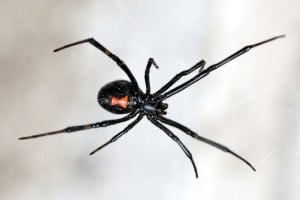
Black widows are one of the most dangerous spiders in the United States. They are common in the southern and western U.S. and like to live in quiet, undisturbed areas of a home. Female black widows are up to one inch long, look shiny, and have a characteristic red or orange hourglass on their backs; male black widows are smaller than the females and don’t have the hourglass. Only the females are toxic; male black widows are harmless.
A bite by a female black widow can cause the following symptoms in pets:
- Drooling
- Rigid muscles
- Incoordination
- Muscle tremors
- Muscle cramping
- Severe muscle pain
- Vomiting and diarrhea
A female black widow’s venom can also cause dangerous blood pressure changes and paralysis of the breathing muscles. If your dog or cat is showing any of these symptoms listed above, take your pet to your veterinarian right away for treatment. Treatment is intensive and includes anti-venom, fluids, muscle relaxants, and pain medications.
Brown Recluse
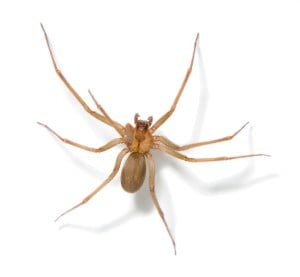 The brown recluse spider is common in the Midwest and Southern U.S. True to its name, this spider, which reaches about one centimeter long, likes to hide in dark, sheltered areas like dark closets, attics, and even shoes. The brown recluse, also known as the “violin” or “fiddleback” spider, has a characteristic violin-shaped mark on its back.
The brown recluse spider is common in the Midwest and Southern U.S. True to its name, this spider, which reaches about one centimeter long, likes to hide in dark, sheltered areas like dark closets, attics, and even shoes. The brown recluse, also known as the “violin” or “fiddleback” spider, has a characteristic violin-shaped mark on its back.
A brown recluse’s venom has substances that cause severe tissue damage. A dog or cat that is bitten by a brown recluse may have the following symptoms:
- Vomiting
- Chronic skin lesions
- Bleeding or bruising
A brown recluse bite can also damage the liver and kidneys, which your veterinarian would be able to detect. Although there is no anti-venom for brown recluse bites, immediate veterinary treatment is required. This treatment includes supportive measures, like wound care.
Hobo spider
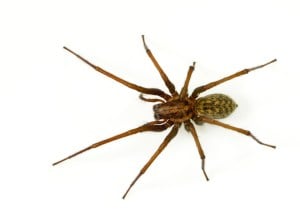 The hobo spider is primarily found in the Pacific Northwest. It is brownish-gray and reaches just under one inch in length. Like the brown recluse, the hobo spider likes to hide in dark places, such as shoes and under the covers. A hobo spider bite causes similar symptoms as those of a brown recluse bite.
The hobo spider is primarily found in the Pacific Northwest. It is brownish-gray and reaches just under one inch in length. Like the brown recluse, the hobo spider likes to hide in dark places, such as shoes and under the covers. A hobo spider bite causes similar symptoms as those of a brown recluse bite.
Be mindful that a spider bite may not show up on your pet for several days. If your pet shows signs of a spider bite, keep your pet from licking the bite site, as this could worsen the symptoms.
Other toxic insects
Household insects are generally nontoxic to pets. For example, silverfish, those 6-legged creatures you may see crawling around in your bathtub, can be a nuisance but pose no danger to your pet. And while roaches aren’t toxic to dogs and cats, they can cause an upset stomach if eaten. Other harmless critters include moths, butterflies, ants, grasshoppers, and crickets.
The insects that are most toxic or harmful to pets include large centipedes (smaller ones will probably not have much venom), scorpions, wasps, and bees, and this is most likely due to the pain these insects will inflict if they bite or sting your pet. They’re not usually found in a human home, but it’s been known to happen in certain geographic areas of the U.S.
Scorpions
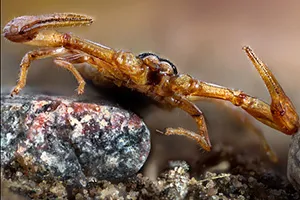 If you live in the American Southwest, it’s smart to be on the lookout for scorpions, which are venomous. While most are not deadly, their sting can still cause pain and tissue damage to pets and should be treated as an emergency.
If you live in the American Southwest, it’s smart to be on the lookout for scorpions, which are venomous. While most are not deadly, their sting can still cause pain and tissue damage to pets and should be treated as an emergency.
Spruce Pets says that of the 70 species of scorpions, the Arizona bark scorpion is the only one considered deadly to both people and pets. If your pet is stung by one, they might yelp in pain and hold a paw up. As the venom works its way through their body, you may see dilated and watery eyes, drooling, trembling or tremors, difficulty breathing, and even collapse.
Your vet will remove the stinger (if it’s still present) and clean the wound. They may also give injections of pain medications and an antihistamine and prescribe oral pain medications to take home.
Scorpions will likely try to avoid you and your pets and like to hide in dark, damp places, so you might see them in shoes, cupboards, or under rocks.
Keep them out
Your best defense against these creatures is to keep them out of your home. Below are some tips for doing so:
- Seal cracks and holes on your home’s exterior.
- Keep the vegetation outside of your home short.
- Clean your home regularly to remove potential insect and spider hiding spots.
- Keep your pet’s food tightly covered to prevent insects and spiders from crawling in.
- Find an environmentally-friendly, nontoxic pest control alternative that can help keep insects out while not poisoning your pet.
Do your best to keep the tiny invaders from setting up shop in your home, but if they do, rest assured that your pet is safe from household insects and most spiders.
Snake bites
Snakes can be found almost everywhere in the world, but especially in tropical and desert climates. If you are planning to travel with your dog to an area that is known to have snakes, do some research ahead of time to know what species are in the area. If you live in an area with predatory and poisonous snakes, keep cats inside and dogs on a leash when they are outside. Most snakes will try to avoid people and pets, so it’s really up to pet parents to keep their pets away.
Prevent outdoor interactions with snakes by:
- Avoiding areas with low shrubbery that can conceal snakes easily and in tropical areas, remember that aquatic snakes can pose a threat. Prevent your dog from wandering into undergrowth that could be hiding snakes. Even when camping and hiking, leashing your dog can prevent snakebites.
- Making sure your dog obeys the command, “Come!” If a snake does cross your dog’s path, it’s important for you to immediately recall your dog – and for them to oblige.
If your dog is bitten by a poisonous snake, he will need immediate veterinary attention. Unfortunately, very small dogs and cats run the risk of being consumed by larger snakes.
Poisonous snake bites can be distinguished by two deep fang marks at the area of the snake bite. Symptoms include bruising, swelling or bleeding of the puncture site, nausea and vomiting, weakness, and difficulty breathing.
Healthy Paws recommends the following with snake bites:
- Do not attempt to release or remove the venom by cutting into the wound
- Do keep your dog calm and try to restrict his or her movement. This can slow the spread of the venom.
- Do not try to suck out the poison
- Do not attempt to apply a tourniquet yourself if you aren’t sure how to do so
- Do try to remember the species of the snake so you can tell the vet
- Do not apply ice to the swelling caused by the snakebite.
All snake bites will need veterinary attention, as it is a wound that will need care. If you suspect your dog or cat has been bitten by a venomous snake, get them to the vet even if they are not showing symptoms. Many venom effects can be delayed, and treatment will be less effective if you wait until the symptoms appear.
Which snakes are poisonous?
While many people find all snakes creepy, only a few species are dangerous to pets and people, and even those will not attack. Most bites are caused by a pet attacking a snake or stepping on it. Here are the most common venomous snakes in the U.S.:
Rattlesnakes
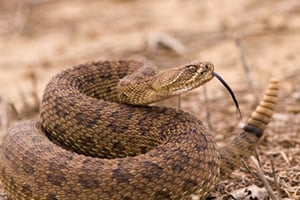 Rattlesnakes, with their distinctive rattle, are probably one of the most feared slithery creatures and for good reason. A rattlesnake bite could be deadly to a dog or cat if not treated quickly.
Rattlesnakes, with their distinctive rattle, are probably one of the most feared slithery creatures and for good reason. A rattlesnake bite could be deadly to a dog or cat if not treated quickly.
Toxicity: Rattlesnake bites are about 25 times more fatal in dogs than in humans, and even more so than cats. Even pets that survive the bite can suffer permanent damage.
Where they live: These large, venomous snakes are found throughout North and South America, with the largest numbers in Southwestern U.S. and Northern Mexico.
Appearance: As long as eight feet, they are thick-bodied with scales in various colors and patterns, and a diamond-shaped head.
Characteristics: They spend some time in dens, which they make in rocky crevices. Upon leaving their shelter, they like to sun themselves on rocks and other open places and lurk in tall grasses and scrub brush.
Avoidance: If you hike with a dog in rattlesnake country, keep them on a leash or open paths and listen for any rattling or hissing noises. Keep cats inside if venomous snakes are common in your area. As a precaution, depending on where you live, you may be able to get a rattlesnake bite vaccine for your pets.
Symptoms: A puncture wound with swelling, excessive drooling, panting, restlessness, whining, or whimpering.
Treatment: Any rattlesnake bite should be addressed immediately by a vet. Veterinarians usually treat rattlesnake bites with antivenin, an injection of antibodies from another animal, intravenous fluids, and pain medications. Close monitoring is essential since the toxins in the venom can sometimes lead to kidney damage.
Coral snakes
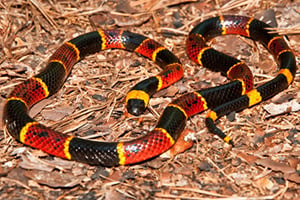 Toxicity: They have some of the most potent neurotoxic venoms among snakes. Their venom can cause paralysis, which affects all muscles, including those used to breathe, which is rapidly fatal for dogs and cats. While highly toxic, coral snakes are unable to release their venom fully in a single strike and a full venom injection requires a chewing-like process and a relatively long bite.
Toxicity: They have some of the most potent neurotoxic venoms among snakes. Their venom can cause paralysis, which affects all muscles, including those used to breathe, which is rapidly fatal for dogs and cats. While highly toxic, coral snakes are unable to release their venom fully in a single strike and a full venom injection requires a chewing-like process and a relatively long bite.
Where they live: There are western and eastern species, both found in the south of the U.S.
Appearance: Brightly colored with primarily black and red stripes with smaller yellow encircling stripes.
Characteristics: Fortunately, these snakes are reclusive and reluctant to bite and tend to be nocturnal, lessening the chances of fatal encounters. The western species prefers dry, rocky areas and desert, while the eastern type prefers leafy forest areas.
Avoidance: Keep your dog on a leash in the habitat where this snake lives, especially at night. Keep cats inside.
Symptoms: Beyond paralysis, your dog or cat may show signs of lethargy, severe and progressive weakness of all four limbs, vomiting, and drooling. Clinical signs can continue to progress for 12 hours after a bite.
Treatment: Get to the vet quickly. If the pet has become paralyzed, the veterinarian may need to ventilate with an oxygen mask. Pet MD says there is a specific antivenom available for coral snake bites. Your pet will be hospitalized for at least two days and full recovery may take months.
Cottonmouth (Water Moccasin) snake
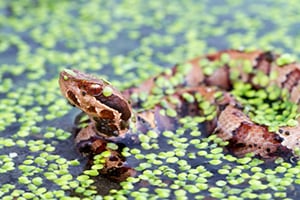 Where they live: North America’s only venomous water snake, they are found in the southeastern U.S. They are semiaquatic, so they may be seen swimming in swamps, marshes, drainage ditches, and at the edges of ponds, lakes, and streams. On land, they’re located near water and fields, says Live Science magazine.
Where they live: North America’s only venomous water snake, they are found in the southeastern U.S. They are semiaquatic, so they may be seen swimming in swamps, marshes, drainage ditches, and at the edges of ponds, lakes, and streams. On land, they’re located near water and fields, says Live Science magazine.
Appearance: Average adult size is two to four feet. The snake has a distinctive blocky, triangular head and a thick body. Water moccasins have dark stripes by each nostril and pale snouts, and the rest of their skin varies from dark brown or black to olive, banded brown, or yellow.
Characteristics: Even though they rarely bite humans or pets, cottonmouths are considered more aggressive than many other snake species because they will stand their ground. They can also bite multiple times, with venom in each bite. When swimming, their entire body is on the surface of the water. Cottonmouth venom is composed mainly of hemotoxins that break down blood cells, preventing the blood from clotting or coagulating.
Avoidance: When walking a dog, be aware of fields and other areas around water.
Symptoms: Dizziness, tremors, bodily weakness, and nausea are all symptoms of venom taking hold.
Treatment: A cottonmouth bite is usually treated with a combination of antibiotics, anti-histamines, and fluid therapy to counter potential hypotension or shock. In severe cases, it may also require antivenin treatment to avoid tissue and muscle damage. Recovery should take less than a week.
Copperhead snakes
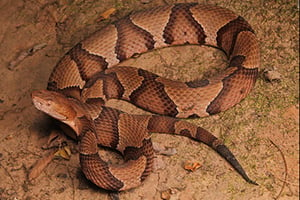 Toxicity: The copperhead’s venom is relatively mild compared to other pit vipers and, while painful, is rarely fatal.
Toxicity: The copperhead’s venom is relatively mild compared to other pit vipers and, while painful, is rarely fatal.
Where they live: Their primary range is along the eastern seaboard as far north as New York and inland as far west as Nebraska.
Appearance: Most copperheads are three to four feet long. As its name suggests, it is usually copper colored with stripes.
Characteristics: The copperhead will often assume a “freeze” strategy when excited or threatened. The copperhead is unique in that most defensive first strikes include no venom. If the snake still feels threatened, a second strike usually has venom.
Avoidance: Since this snake is considered non-aggressive, the real danger is stepping on it as it has excellent camouflage qualities. With dogs, keep them on leash, stay on open paths, and be alert.
Symptoms: Even if there is no venom delivered, you may see a puncture wound with swelling and bruising around the bite. A poisonous bite may cause excessive drooling, panting, restlessness, lethargy, whining or whimpering.
Treatment: With a non-venomous bite, the bite will be treated as a puncture wound, with wound cleaning, antibiotics, antihistamines, and anti-inflammatory medications. If venom was injected, the bite is usually treated with a combination of antibiotics, antihistamines, and fluid therapy to counter potential hypotension or shock.
Another critter to avoid
Orange Bellied Rough Skinned Newt
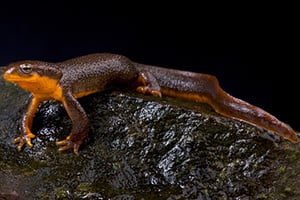 If you live in the Pacific Northwest and spend a lot of time recreating outdoors, beware the Orange Bellied Rough Skinned Newt, the Pet Poison Helpline says. This innocent looking amphibian packs a self-defensive punch that can be deadly. Making his home in coastal forested areas, he typically hangs out near ponds where curious dogs and other pets sometimes encounter him. This large salamander can be recognized by his bright orange underside and bumpy, rough skin covering his upper half. If this newt is disturbed, a milky substance containing tetrodotoxin is released. If ingested, it can quickly cause severe symptoms, including tingling and numbness of the lips and face, drooling, vomiting, diarrhea, and abdominal pain. These symptoms progress quickly to motor dysfunction and then to a life-threatening situation with difficulty breathing and paralysis. Seek emergency veterinary care immediately if you suspect your pet had a run-in with a newt.
If you live in the Pacific Northwest and spend a lot of time recreating outdoors, beware the Orange Bellied Rough Skinned Newt, the Pet Poison Helpline says. This innocent looking amphibian packs a self-defensive punch that can be deadly. Making his home in coastal forested areas, he typically hangs out near ponds where curious dogs and other pets sometimes encounter him. This large salamander can be recognized by his bright orange underside and bumpy, rough skin covering his upper half. If this newt is disturbed, a milky substance containing tetrodotoxin is released. If ingested, it can quickly cause severe symptoms, including tingling and numbness of the lips and face, drooling, vomiting, diarrhea, and abdominal pain. These symptoms progress quickly to motor dysfunction and then to a life-threatening situation with difficulty breathing and paralysis. Seek emergency veterinary care immediately if you suspect your pet had a run-in with a newt.
Does Pet Insurance Cover Toxic Bites?
A Healthy Paws Pet Insurance plan would cover treatment for any poisonous bites or stings. That includes emergency or specialty care, which typically costs two to three times more than standard veterinary services. Healthy Paws reimburses you at the same high reimbursement rate as your primary veterinarian.
Emergencies caused by snake and spider bites need quick thinking and action. By enrolling in pet insurance you can save up to 90% on vet bills, so you can say “yes” to life-saving procedures at the vet and get the critical care your pet needs. Start by getting a free quote.
Content provided by JoAnna Pendergrass, DVM. Dr. Pendergrass is owner and founder of JPen Communications, a medical communications company specializing in consumer education.







